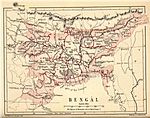Our website is made possible by displaying online advertisements to our visitors.
Please consider supporting us by disabling your ad blocker.
Vanga kingdom
Vaṅga | |||||||||||
|---|---|---|---|---|---|---|---|---|---|---|---|
| c. 1100 BCE–c. 340 BCE | |||||||||||
 Vanga and erstwhile neighbors in ancient India | |||||||||||
| Capital | Kotalipara (present-day Gopalganj district, Dhaka division, Bangladesh) | ||||||||||
| Common languages | Vedic Sanskrit | ||||||||||
| Religion | Historical Vedic Religion | ||||||||||
| Government | Monarchy | ||||||||||
| Raja (King) | |||||||||||
• c. 10th century BCE | Samudrasena | ||||||||||
• c. 9th century BCE | Chadrasena | ||||||||||
| Historical era | Iron Age | ||||||||||
• Established | c. 1100 BCE | ||||||||||
• Disestablished | c. 340 BCE | ||||||||||
| |||||||||||
| Today part of | Bangladesh India | ||||||||||
| History of Bengal |
|---|
 |
Vaṅga was an ancient kingdom and geopolitical division within the Ganges delta in the Indian subcontinent.[1] The kingdom is one of the namesakes of the Bengal region.[2] It was located in eastern and southern Bengal. Vanga features prominently in the epics and tales of ancient India as well as in the history of Sri Lanka.
Vanga was probably the centre of the Gangaridai Empire mentioned by numerous Greco-Roman writers. The exact capital of ancient Vanga kingdom could not be identified. After the rule of the Gupta Empire, ancient Bengal was divided into two independent kingdoms – Gauda and Vanga. Kotalipara, an ancient fortified city of Vanga kingdom, present-day in Gopalganj district of Dhaka division, is considered as the capital of Vanga kings.[3]
Indian and Greco-Roman writers referred to the region's war elephants. In Indian history, Vanga is notable for its strong navy. There are numerous references to Vanga in the Hindu epic Mahabharata, which is one of the two major Sanskrit epics of India. The other epic, the Ramayana, mentions the kingdom as an ally of Ayodhya.
- ^ "The Rise of Islam and the Bengal Frontier, 1204–1760". publishing.cdlib.org. Retrieved 14 June 2021.
- ^ "West Bengal | History, Culture, Map, Capital, & Population". 11 February 2024.
- ^ Sultana, Jesmin. "Kotalipara". Banglapedia. Retrieved 29 November 2024.
Previous Page Next Page


